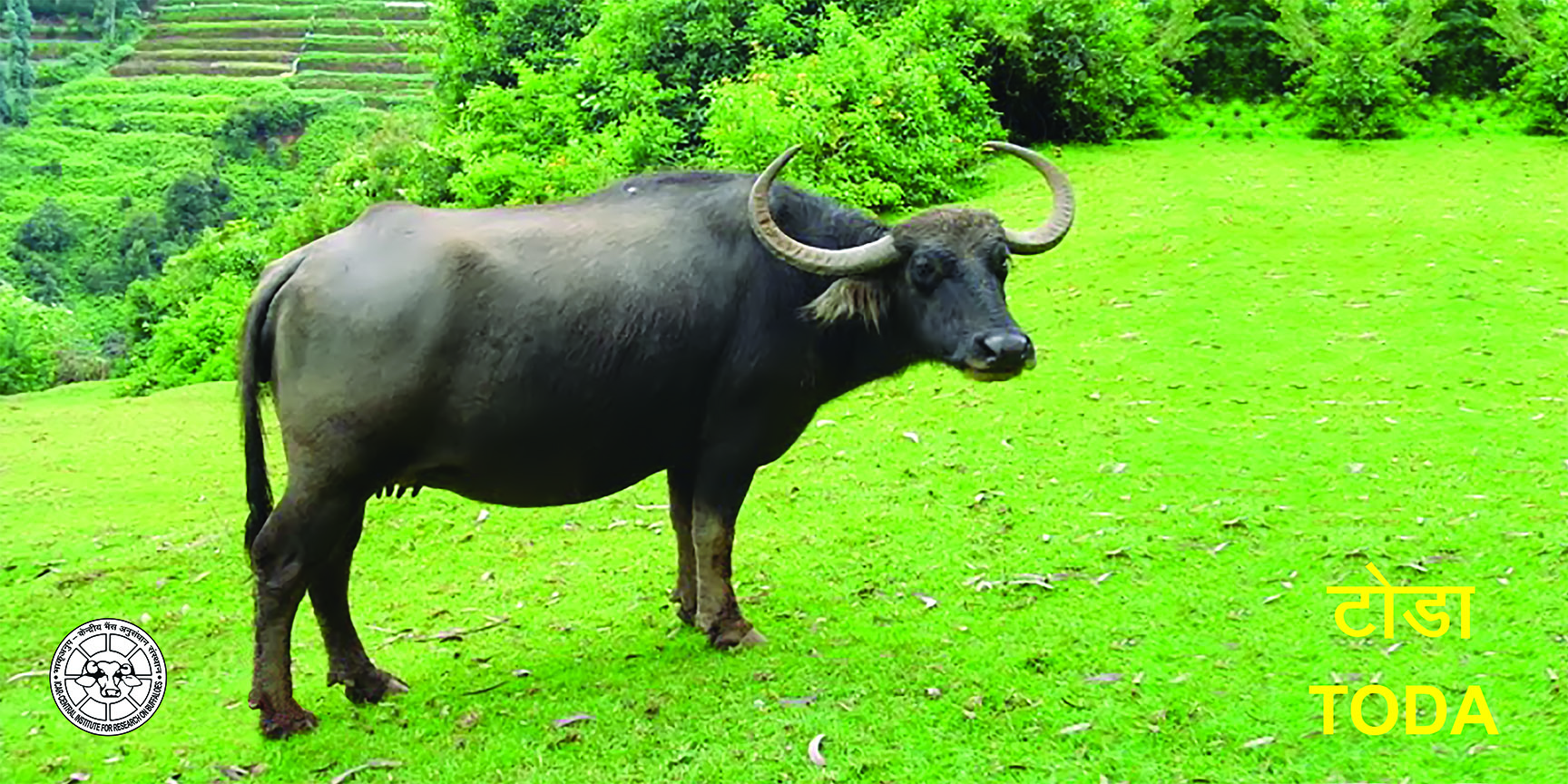Toda
- Origin & Breeding Tract
- Population
- Physical Characteristics
- Biometry
- Production Traits
- Housing Management & Practices
All the anthropological studies of the tribe recorded the wholly dependent nature of the pastoral society on the buffaloes for their livelihood. The existence of this buffalo could be traced back from the earliest reference of Finicio (1603) who wrote of the tribe: “They have no crops of any kind, and no occupation but the breeding of buffaloes, on whose milk and butter they live”. Rivers (1906) and Walker (1986) made a detailed account on the Toda buffaloes, dairy organization and Toda religious observance focused on this animal and its care. Apart from the Todas, who predominantly own these buffaloes (hence named after the tribe), other communities such as Badagas and Kotas also maintain them in small numbers.
Among Indian breeds of buffaloes, the Toda buffalo is a unique breed and a genetically isolated population, confined to the Nilgiri hills of Tamilnadu. These buffaloes are reared mainly by the Toda tribes who are among the most aboriginal inhabitants of this country.
Some of the important characteristics is described as follows: –
| Body color | Toda buffaloes are ash grey coloured.Color of the calf is generally fawn at birth which varies from grey, light grey and dark grey. In growing calves, at about 2-3 months, the fawn color changes to ash grey. | |
| Horns | The horns are quite large, set wide apart, outward, upward to form a characteristics semicircle.The Crescent-shaped horns with sharp tip and two chevron markings in the neck region, are the distinguishable features of Toda buffaloes (Karthikeyan et al. 2002a). | |
| Marking | ||
| Eye | ||
| Tail | Tail is long and slim extending beyond hock joint and the switch is generally black. | |
| Body | Toda buffaloes are medium in size and is considered to be quite powerful. Body is fairly long with a broad and deep chest | |
| Head | Head is large heavy, carried to the level of body. | |
| Face | ||
| Neck | ||
| Ear | ||
| Limbs | ||
| Skin | ||
| Udder | Udder is small and not so prominent | |
| Teats |
Body weight and Growth Rate
The mean values of body weight at birth, 6, 9,12,18,24 months and at first calving reported by various workers are presented below.
|
Stage |
Mean +- S.E(Kg) |
Mean +- S.E(Kg) |
|
At Birth |
– | – |
|
3 months |
– | – |
|
6 months |
– | – |
|
9 months |
– | – |
|
12 months |
– | – |
|
18 months |
– | – |
|
24 months |
– | – |
|
At first calving |
– |
Morphological Characteristics
Various values of morphological traits of Toda buffaloes like body length, height at withers, heart girth and adult weight are given in the following table.
| characteristics | Mean ±S.E |
| Body Length (cm) | 133 ± 0.10 |
| Height at withers (cm) | 122 ± 0.60 |
| Hearth Girth(cm) | 180 ± 1.10 |
| Birth Weight(Kg) | |
| Adult weight(Kg) |
Performance of Toda buffaloes based on the sample recording of farmers animals'(Balchandran, 1996) is given in the following table.
| Traits | Karthikeyan et al.,2002b | Balachandran,1996 |
| Average lactation length(days) | – | 198.6±2.8 |
| Average 305 day lactation milk yield (kg) | – | 501±10.6 |
| Average daily milk yield (kg) | 2.53±0.06 | 2.53±0.44 |
|
Peak milk yield (kg) |
6.65 |
– |
|
Average Fat% |
8.27% rang (4.8 to 14%) | 8.22±0.08 |
| Average SNF% | – | – |
.
The average daily milk yield in Toda buffaloes was reported to be 2.53 ± 0.06 kg (Karthikeyan et al., 2002b) in the above table with the maximum yield of up to 6.65 kg. This is considered to be satisfactory, considering the primitive level of management and maintenance of these buffaloes on grazing alone. Besides, Toda buffaloes are known for high milk fat content of 8.27 per cent with the range of 4.8 to 14 per cent.
Housing
The husbandry practices of Toda are of primitive in nature; the calf pen and houses are made of locally available wooden stakes, mud and stones. The buffaloes are housed in a circular enclosure without roof.
Feeding
These buffaloes are exclusively thriving on grazing alone. No money is spent on feeding these animals as no concentrate or supplementary feeding is practised.
Breeding
No males are maintained in the herd. Instead, the buffalo cows are sired by the buffalo stud bulls roaming in the forest (in feral state).Only natural mating occurred.The average age at first calving is 4 years and thereafter they become regular breeder (once in 14 months). There is a marked seasonality in calving as most of the animals calve mainly during the months of July to October.
Cultural Associations
Some of the important cultural practices associated with the buffaloes are listed below:
- Naming of buffaloes : Each and every buffalo cow is named individually, soon after her first calf is born, which is followed as a routine ritual practice.
- Exchange of buffaloes : The buffalo cow along with its calf is exchanged during the marriage ceremony as dowry.
- Ceremonial slaughter: Buffalo cows are slaughtered for ceremonial purposes to propitiate the dead relatives of the clan.
- Migration : It was customary that some buffaloes would migrate from one place to another in search of pasture during dry season that lasts from January to March.

